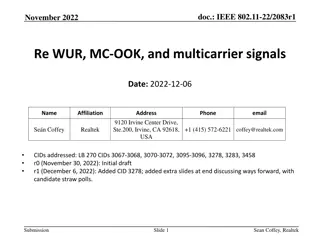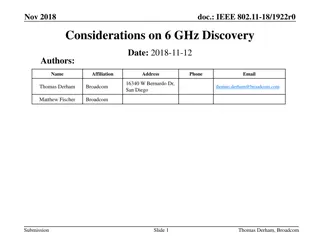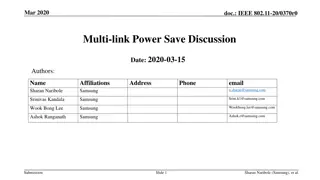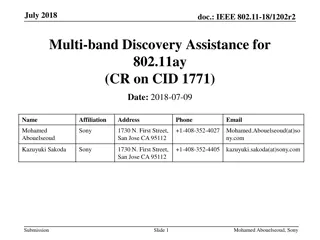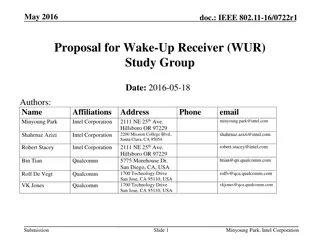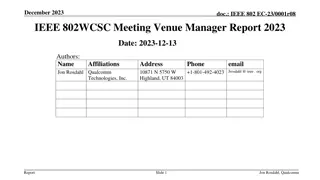Power-Efficient WUR AP Discovery in IEEE 802.11
Discussion on issues related to Access Point (AP) discovery using Wake-Up Radio (WUR) when the AP is in sleep mode, focusing on active scanning methods for quick AP discovery and association, including power-efficient wake-up frames and challenges with broadcast frames in IEEE 802.11 networks.
Download Presentation

Please find below an Image/Link to download the presentation.
The content on the website is provided AS IS for your information and personal use only. It may not be sold, licensed, or shared on other websites without obtaining consent from the author.If you encounter any issues during the download, it is possible that the publisher has removed the file from their server.
You are allowed to download the files provided on this website for personal or commercial use, subject to the condition that they are used lawfully. All files are the property of their respective owners.
The content on the website is provided AS IS for your information and personal use only. It may not be sold, licensed, or shared on other websites without obtaining consent from the author.
E N D
Presentation Transcript
November 2016 doc.: IEEE 802.11-16/1400r0 Power Efficient WUR AP Discovery Date: 2016-11-07 Authors: Name Xiaofei Wang Affiliations Address InterDigital Communication Inc. Phone +1 631.622.4028 email Xiaofei.wang@interdigital .com 2 Huntington Quadrangle Melville, NY 11747 Joseph Levy Rui Yang Submission Slide 1 Xiaofei Wang (InterDigital)
November 2016 doc.: IEEE 802.11-16/1400r0 Abstract In this contribution, we discuss issues related to AP discovery using WUR when the AP is in the sleep mode. Submission Slide 2 Xiaofei Wang (InterDigital)
November 2016 doc.: IEEE 802.11-16/1400r0 Introduction Traditionally, an 802.11 STA may utilize two methods for AP discovery Passive scanning: by monitoring APs Beacons, Measurement Pilots, FILS Discovery frames, etc. Active scanning: by transmitting Probe Request frames to solicit Probe Response frames from APs For APs equipped with WURs, APs primary connectivity radios may be in the sleep mode for an extended period of time with their WUR turned on [1] A STA may not be able to readily discover the presence of the desired AP A similar mechanism to active scanning may be desired for WUR STAs that require low latency, and hence speedy AP discovery and association Submission Slide 3 Xiaofei Wang (InterDigital)
November 2016 doc.: IEEE 802.11-16/1400r0 Active Scanning for WUR (1) A WUR STA can send a wake up frame to wake up one or more WUR APs to discover a suitable AP Such wake up frames can be either a unicast or a broadcast frame Unicast wake up frame is power efficient Only one AP needs to evaluate the frame and turn on its primary connectivity radio if needed However, unicast wake up frame for a specific AP is not always possible The initiating STA must know the BSSID/identifier of the desired AP Could be time consuming May be useful when the STA has pre-acquired knowledge of the presence of the AP, e.g.: From a previous association (and maybe some information, such as location) Directed by other APs Submission Slide 4 Xiaofei Wang (InterDigital)
November 2016 doc.: IEEE 802.11-16/1400r0 Active Scanning for WUR (2) Broadcast wake up frame may be very inefficient in power consumption All APs must decode the entire wake up frame Without specific information, it is hard for the receiving APs to decide individually whether they should turn on their primary connectivity radio The STA only needs to associate with one AP Wasteful for many APs to turn on their primary connectivity radios and transmit beacon/probe response Too many Beacon/Probe Responses frames already! [3] Malicious devices may want to wake up APs often to drain their batteries [3] APs could be obvious targets for attacks on the WLAN networks Some optimization may be desired. Submission Slide 5 Xiaofei Wang (InterDigital)
November 2016 doc.: IEEE 802.11-16/1400r0 Active Scanning for WUR (3) Not all APs need to wake up when receiving a broadcast wake up frame meant for AP discovery If a STA desires APs with, e.g., a certain SSID, then an AP of a different SSID need not to wake up, i.e., turning on their primary connectivity radio Otherwise, that AP just wastes power by: Turning on its primary connectivity radio Waiting for a Probe Request; or send a Beacon/Probe Response AP may turn off primary connectivity radio after receiving a Probe Request with no matching SSID, or after responding with a Probe Response and don t hear from the STA after some timeout duration In summary, nothing is achieved but energy was wasted Submission Slide 6 Xiaofei Wang (InterDigital)
November 2016 doc.: IEEE 802.11-16/1400r0 Active Scanning for WUR (4) More power efficient to have the initiating STA including information on desired BSS s or SS s in the broadcast wake up frame APs with different BSSIDs/SSIDs can ignore the wake up frame Further optimization is possible for APs of the desired SSID Other optimization may also be desired to avoid that APs needlessly turn on their primary connectivity radios Submission Slide 7 Xiaofei Wang (InterDigital)
November 2016 doc.: IEEE 802.11-16/1400r0 Conclusion A WUR AP discovery mechanism similar to active scanning for regular 802.11 STAs may be desirable for fast AP discovery and association Broadcast wake up frame used for AP discovery can be very inefficient in power consumption, but may be necessary in some scenarios Including one or more BSSID/SSID in the broadcast wake up frames used for AP discovery can provide power saving for WUR AP discovery Submission Slide 8 Xiaofei Wang (InterDigital)
November 2016 doc.: IEEE 802.11-16/1400r0 References [1] 11-16/1045r6, A Proposed PAR for Wake Up Radio, Sept. 2016 [2] 11-16/0939r1, WUR-based Power Save Operations for AP, July 2016 [3] 11-11-1413r3, Real air-time occupation by beacon and Probe, January 2012 [4] 11-16/0927r0, Securing the WUR, July 2016 Submission Slide 9 Xiaofei Wang (InterDigital)






